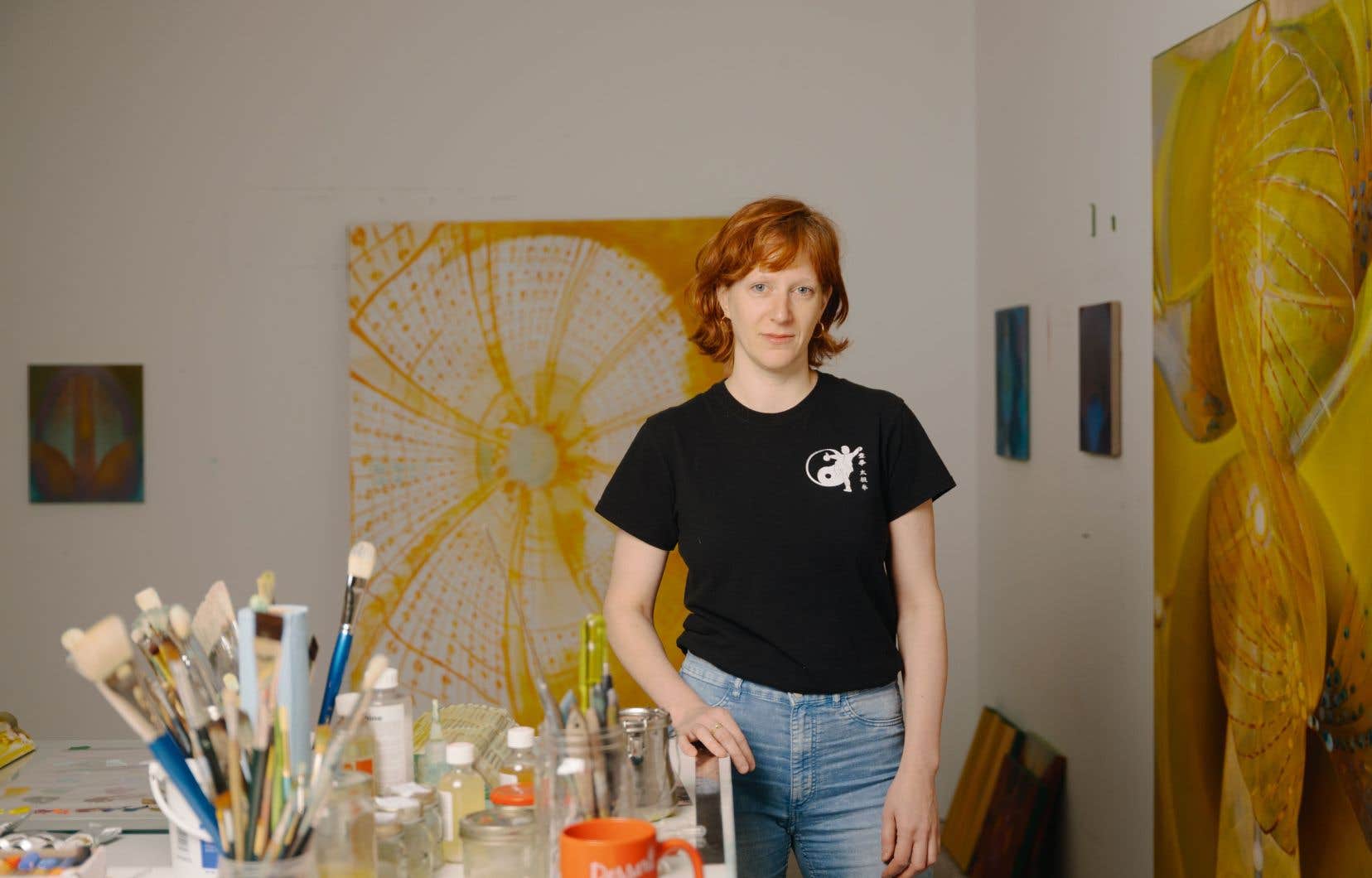To understand how local artists shape the material to extract their vision of the world, you have to meet them. Spotlight is a series of portraits that appears every end of the month. Forays into the world of creators who work on their works in unusual ways, away from current cultural events.
Élise Lafontaine’s work reflects her career: extraordinary. The artist thus welcomes us into his Rosemont studio one chilling January morning and his welcome certainly contrasts with the ambient air. Between a warm smile and natural generosity, she indulges in a fascinating flow of words. On the walls hang canvases which, even if they are not finished, already absorb the observer because of their bright, almost incandescent colors, their format – very large or very small – and their movements like gentle undulations which carry us along. The approach is disconcerting, both architectural and visceral. “I try to work with places, to meet those who will invite me to suspend time and change my perspective,” she says.
A bit like Tarkovsky’s “Zone” in his film Stalker, the sensation of being “other” in these spaces with blurred contours is what guides Élise Lafontaine in her approach, making us even more dizzy. “I don’t know what I’m looking for, but the places that call to me are very linked to each other, and that’s why I allow myself to juxtapose them in my paintings,” explains the artist, who uses This is done using the glaze technique. On his work table, everything is carefully classified, arranged, organized, and a few plans materialize his intuition. “I started to structure myself a little more recently, because I know that my paintings are going to change so much,” she confides.
The one who, when younger, wanted to be an architect today uses this art as a pretext to paint. “I tell myself that there are many women before me who have connected the female body to architecture,” says Élise Lafontaine, who notably mentions Hilma af Klint and Agnès Varda. This constrained body which at the same time desires to emancipate itself therefore becomes a reference for her. “I start with very concrete ideas, concepts, which then metamorphose into abstractions. » This ambiguity in the work then has the potential to disorient those who look, as if one were suddenly lost in a labyrinth, almost trapped. “In our performance society, this notion is too often dismissed, but perhaps we need wandering. » With this in mind, she allows herself the freedom to turn the canvas as she paints. “Sometimes I only find the meaning of the painting at the last second,” adds the artist.
Originally, a cave
If she is often compared to artists Loie Hollowell and Carmen Herrera, who are interested in the abstract through color and shape, Élise Lafontaine points out that, for her part, symbolism is always very strong. According to her, exploiting the concept of the cave allows her, among other things, to turn away from pure abstraction to better destabilize others. “Vision adjusts to the darkness, there is no longer any real distinction between the red rock, the cave and oneself. We lose its contours through sound, through the experience of seeing in total darkness. You see everything in gray, and when a little light appears, everything turns red as if you were inside your mother’s womb or your own body,” says the Montrealer.
Élise Lafontaine knows well what she is talking about, since while she was studying for a master’s degree at UQAM, she went to Ariège, in France, for an immersion in the Lombrives cave. She was then going through a phase of existential questioning and, well before the pandemic, dreamed of what the imagination could mean in a situation of confinement. “I stopped painting and went to the origins of painting: I didn’t understand it right away, it’s fascinating,” she says. And continues: “They gave me the key to the cave and I set up my tent in its immense cathedral. In that moment, I felt a connection between the liberation of the female body and leaving the frame. »
Deeply marked by this aesthetic learning, the artist admits to having emerged from it uninhibited. “Strangely, it made me want to question my materials, the circulation around a work,” she explains.
During the writing of her dissertation, which focused on the notion of threshold, Élise Lafontaine, also keen on psychology, also experienced a decisive moment. “I did a residency in a hospital in Malévoz, Switzerland, where artists offer workshops to patients with the aim of putting rust in the well-sealed machine of psychiatry and breaking down the walls between it and the city, she says. It’s funky, but when people come to the hospital to see art, it helps break the taboos surrounding mental health. »
Taking the exercise very seriously, Élise Lafontaine asked patients to take her to their favorite place to meditate. “For two of them, they were very old abbeys, and that’s where I started taking photos of vaults. It immediately made me think of a woman’s body, enveloping and threatening at the same time, with the force of stone and the trajectory of sound,” she relates, still visibly elated.
Back at his studio, the idea came to him to juxtapose images of vaults and those of his tent in the Lombrives cave. “By focusing on sensations and combining all these places that have different stories, I really took the path of abstraction,” emphasizes Élise Lafontaine.
Since then, she has mostly relied on her instincts. “I try to stay open, because painting can make us discover things. There are spaces that arrive,” points out the artist. For her, art serves above all to bring forms into existence. “I have nothing to teach anyone. I think that when people come into contact with the works, they feel. I trust them feeling. »
